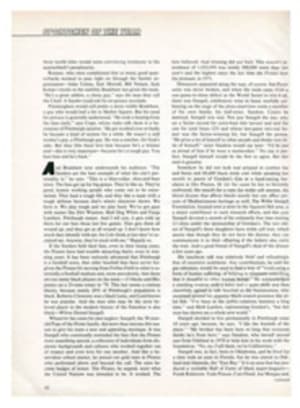
SPLENDOR IN THE DESERT SKY
Like seven-story Christmas tree ornaments, they waft over a New Mexico mesa, their pilots riding in wicker baskets suspended beneath sheer nylon "envelopes." On landing, the hot-air balloonists stuff their big bags into little bags, hoist the gondolas onto pickups and roll to the next launch site. At $9,000 a balloon and $100 an hour for expenses, it isn't a cheap avocation, but those who do it say it's worth every cent. Turn the pages for more views of a grand gathering at Albuquerque, where the winds are fickle but fun, and an appreciation of the lift one gets from hot-air ballooning.
TRYING TO OUTBOX THE BOX
A half dozen ebony teardrops hover overhead, barely silhouetted against the dark of the desert sky. It is 5 a.m., the air is calm, and a half moon sits high above the Sandia Mountains, which loom in the distance to the east. Spectators await the light of dawn in anticipation of a new day and a sun to ward off the chill that has settled over the stark New Mexico terrain. A sudden whoosh cuts through the stillness. Seconds pass, then one tiny teardrop takes on a glowing pattern of pinks and reds. Another whoosh, and a second globe unveils its colors. And again and again, like light bulbs turning on to wake the mesa from its sleep.
The early-bird dawn patrol is in action on the last day of the Eighth Annual International Balloon Fiesta at Albuquerque. A few hours later 376 hot-air balloons, by far the most ever gathered in one place in the history of ballooning, will ascend together from Simm's field in a final display of unmatched splendor. The mass launching will be the culmination of 10 days of competition during which the activities have been more like free-form games than tough contests, an excuse for balloonists from all over the world to get together, "kick dust" and generally have fun doing what they like to do best, which is everything that has anything to do with ballooning.
Small wonder that there should be such a congregation at Albuquerque, because it boasts of being "the balloon capital of the world." It is home to the current hot-air balloon world champion and runner-up, as well as to the transatlantic team that flew the gas balloon Double Eagle II, and it has some of the best weather in the world for ballooning. "We have what is known as the Albuquerque box," says Cherries Jubilee's owner, Jerry Mason. "It's got tricky strata of air, much like a layer cake. At various altitudes the air moves in different directions. You might be heading one way at the 1,000-foot level, while 50 feet higher it's the opposite. By going up and down you can change your track, and sometimes you even end up where you began."
Competitors from the eastern U.S. were having special trouble negotiating the unusual patterns of air, because they are accustomed to moving in a single direction, west to east. But by the end of the fiesta they were fascinated by, if not quite adept at solving, the problem of maneuvering their balloons.
To be sure, there were those who found the competition just plain frustrating. Few pilots managed to get anywhere near the target in the tumbleweed drop, which entails trying to hit an "X" on the ground with a clump of tumbleweed released from 500 feet up. And during the roadrunner-and-coyote event, hundreds of ballonists failed to get within beep-beeping range of the lead balloon they were chasing. For at least two competitors, however, the "box" proved solvable. In the fiesta's most difficult accuracy contest, someone was right on the nose for the first time ever. Two someones, in fact. Ray DeMeritt, a schoolteacher from Paso Robles, Calif., swooped down to snatch the keys to a four-wheel-drive Scout from the top of a 20-foot pole. Half an hour later, that feat was repeated by Dudley Mann, an El Paso attorney. Both men were awarded the Scouts that went with the keys.
A hot-air balloon, as its name suggests, gets its lift from hot air, which is heated by a propane burner mounted at the mouth of the envelope. Seconds after the gas is lit—usually for blasts of two or three seconds—the balloon rises; as the air cools, it descends. Otherwise a balloon must go where the wind takes it.
No one knows the ways of the winds better than Bill Barrett, a bird colonel at nearby Kirtland Air Force Base who has flown in every kind of balloon in the 25 years he has been in the service and who now pilots the Roadrunner. "You've heard of hanging on by the seat of your pants? Well, flying a balloon is done by the soles of your feet," he says as he floats along over the desert. "That's where you feel the rise and fall. Forget the altimeter. It only shows you what's already happened." A balloon's response is a delayed reaction, he goes on to explain, while opening the valve on one of two 20-gallon propane tanks aboard Road runner's gondola and looking to his feet for the reaction. "What the pilot must do is anticipate the unexpected, and everything about ballooning is unexpected."
Barrett drifts off, bobbing up and down, in search of an air current that will carry him back to the launching site—or at least to a place where his chase crew can pick him up. Ultimately he aborts, suspended in still air over a schoolyard. After descending, Barrett tells the children, who are at recess, that he will give them their first balloon rides. Thirty go up, three at a time.
Now, on mass ascension day, the first pink flush of dawn pervades the desert, and thousands of spectators shuffle dust into what becomes a haze. Crews bustle in preparation for the launch. Inflators rasp, burners roar. Willing hands tug at limp and lifeless cloth until it billows fat and round. The smiling face on the Great Pumpkin appears, and the patchwork quilting of Raggedy Ann, then a peacock, a unicorn and Cat Balloon. A blast of gas igniting is heard, then another, and one by one the balloons rise, like Christmas ornaments, majestically, mysteriously, floating in air.
SIX PHOTOS
SEBASTIAN BASTEL AND VINCE STREANO

